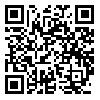BibTeX | RIS | EndNote | Medlars | ProCite | Reference Manager | RefWorks
Send citation to:
URL: http://ptj.uswr.ac.ir/article-1-278-en.html

 , Zahra Mosalla Nezhad *1
, Zahra Mosalla Nezhad *1 
 , Afsoon Nodehi Moghaddam1
, Afsoon Nodehi Moghaddam1 
 , Enayat Allah Bakhshi2
, Enayat Allah Bakhshi2 
 , Shapoor Jaberzadeh3
, Shapoor Jaberzadeh3 

2- Department of Biostatistics, University of Social Welfare and Rehabilitation Sciences, Tehran, Iran.
3- Department of Physiotherapy, Faculty of Medicine, Nursing and Health Sciences, Monash University, Australia.
Purpose: Increased life expectancy leads to an increase in the elderly population. However, with an increase in the age, the number of chronic diseases and cognitive disorders also increases. Since the social, cultural, environmental, lifestyle and health-related behavior is specific to each nation, the present study aimed at investigating the relationship between socio-economic status, health, physical fitness, and cognitive function in older adults with functional performance in Iran.
Methods: It is a cross-sectional study involving 42 older adults (20 women, 22 men) through a survey questionnaire and accessible sampling method. The age range of the study participants was 60 to 91 years. The questionnaire was used by the examiner to collect information on the age, height and weight, history of diseases, health status, physical fitness, and socio-economic status, for assessing the functional performance of older adults. The three performed tests included Sit-to-Stand test to examine the strength and lower extremity function, the Timed Up and Go (TUG) test to measure the speed and balance while walking and the Purdue Pegboard Test (PPT) for measuring the hand function. A step-wise regression model analysis was applied by using SPSS (version 19).
Results: In sit-to-stand test, the test of significance of regression coefficients was profound in case of dependent variables (marital status (P=0.003) and overweight (P=0.014)). In TUG test, the dependent variables, age (P=0.002), marital status (P=0.081), and cognitive function (P=0.048) were influential on the TUG performance. In PPT, the independent variables, age (P=0.041), gender (P=0.012), marital status (P=0.058), and cognitive function (P=0.001), had a significant effect on the hand function.
Conclusion: Age-related changes, cognitive functions, and socioeconomic status were the most important factors affecting the functional performance of the elderly. Weight and gender also affected some aspects of functional performance. The author further recommends controlling and preventing loss of cognitive function and improving the social status and age-related changes in the older Iranian adults.
Received: 2015/09/2 | Accepted: 2016/01/9 | Published: 2016/04/1
| Rights and permissions | |
 |
This work is licensed under a Creative Commons Attribution-NonCommercial 4.0 International License. |



